|
|
File
Civic Museum – Belluno
|
Piazza Duomo 16 – 32100 Belluno (BL)
– Fax 0437 944836 |
  |
|
Summary
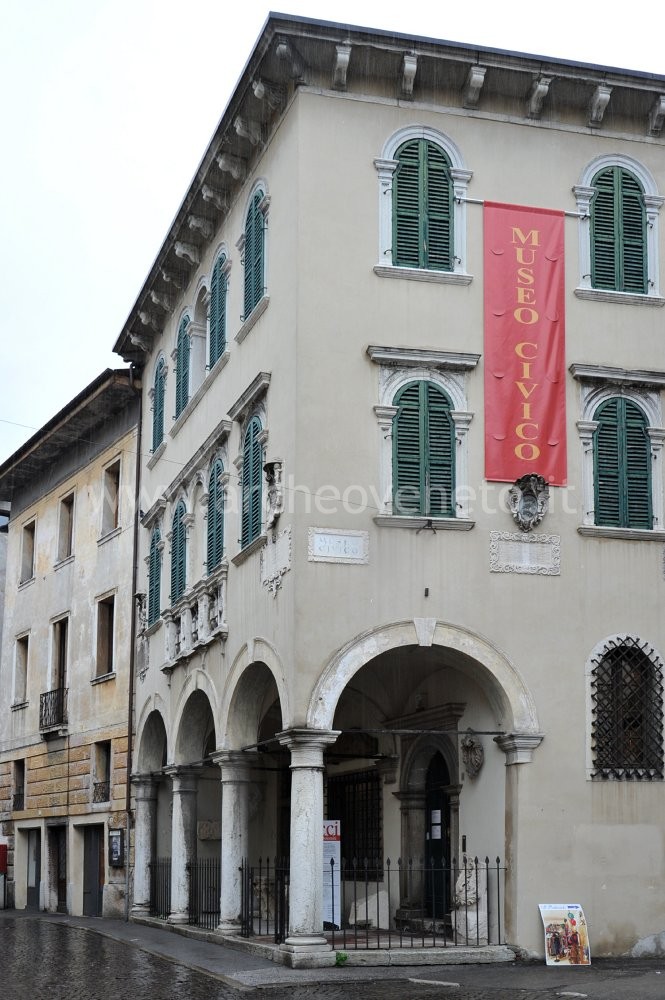
The archaeological section of the museum is located at the ground floor of Palazzo dei Giuristi, where at the upper floors other sections and the picture-gallery are located. The exposition of the archaeological finds is displayed into two rooms (the second is being re-fit out) rich of evidences of the Prehistoric age, of the Ancient Venetic Age, of the Roman age and of the Early Middle Ages which are related to the city and its province. The collection of the Museum includes even the lapidary located in the passage-way of the nearby Auditorium and a Roman sarcophagus held by the Municipal Library (Palazzo Crepadona).
Collection history
The establishment of the Civic Museum of Belluno dates back to 1872, thanks to the donation to the city of the collection of paints belonging to the physician from Belluno Antonio Giampiccoli. Collections of bronze objects, medals, metal plates, coins, seals, manuscripts and and books of local interest beloging to Lord Florio Miari were added to this originary core. The exposition was located in the Palazzo dei Giuristi, built in 1664. The Museum opened to the public in 1876 and, concerning the archaeological section, today it displays also many important finds from recent excavations led by the Soprintendenza per i Beni Archeologici del Veneto (particularly in the Aurignacian site of Campon di Monte Avena and, above all, in the Epigravettian one of Riparo Valbruna in Val Cismon).
|

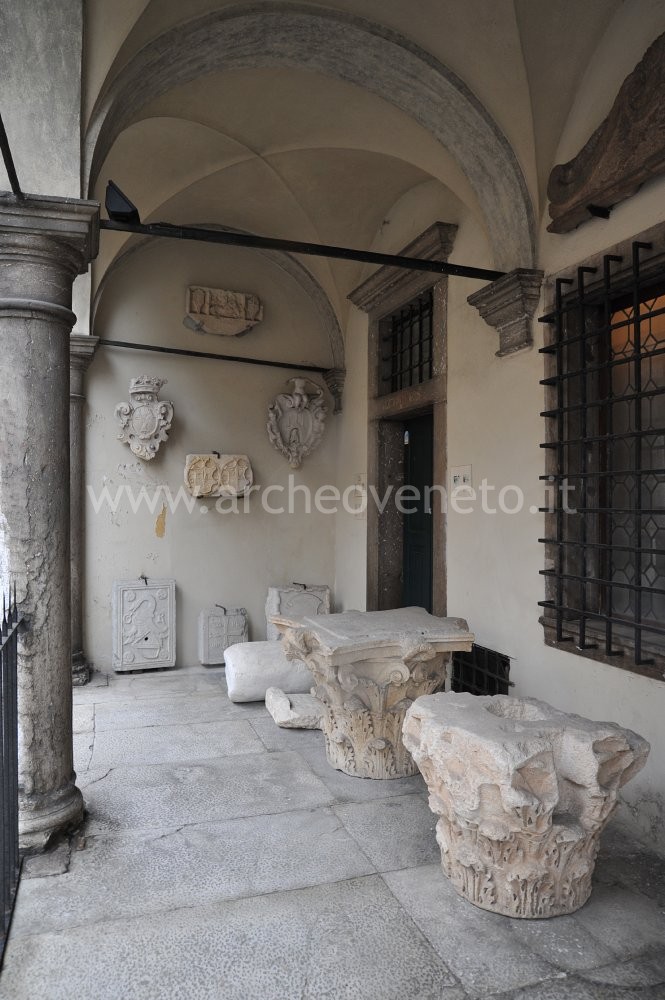 In the entrance loggia of the museum, among modern heraldic bearings and inscribed tablets, two big lithic Corinthian capitals discovered in Belluno (porta Dante and Fiammoi), both dating back to the 2nd-3rd cent. A.D., are located. In the entrance loggia of the museum, among modern heraldic bearings and inscribed tablets, two big lithic Corinthian capitals discovered in Belluno (porta Dante and Fiammoi), both dating back to the 2nd-3rd cent. A.D., are located.
|

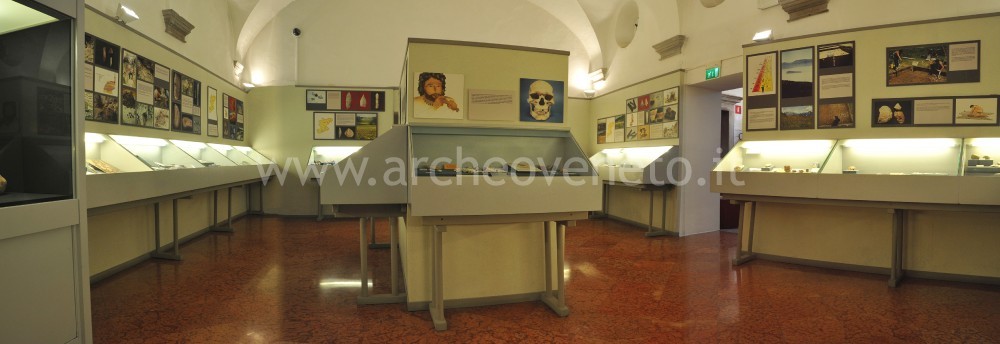 The first rooom is entirely dedicated to the Prehistory and Protohistory of the land of Belluno; it is introduced by a panel located opposite to the doorway, which deals with the sequence of the archaeological sites from the Musterian (Mid Paleolithic) to the Bronze Age; the panel frames a part of a polychrome geometric mosaic from via S. Lucano (3rd-4th cent. A.D.). The first rooom is entirely dedicated to the Prehistory and Protohistory of the land of Belluno; it is introduced by a panel located opposite to the doorway, which deals with the sequence of the archaeological sites from the Musterian (Mid Paleolithic) to the Bronze Age; the panel frames a part of a polychrome geometric mosaic from via S. Lucano (3rd-4th cent. A.D.).
The exposition starts with a close sequence of cases arranged along the sides of the room, starting from the left; each case is completed with clear illustrative panels hung on the wall. Introduced by a presentation about the development of the lithic industry from the Low Paleolithic to the Neo-Eneolithic, the first six cases, arranged along the first two walls, describe in detail the finds discovered in the site of Campon di Monte Avena, dating back to the Aurignacian phase of the Upper Paleolithic (about 30000 years ago). The exposition collects a great number of lithic tools discovered during the excavation of one of the very rare open air Prehistoric mines located in Europe. In this phase, flint veins on the mountain-top were largely exploited and the raw material which was mined was worked in place. The productive process is well explained by the last display cases, which illustrate the work steps recorded in the site. In the left corner at the back of the room there is a reconstruction of the Tomb of the Hunter, discovered in Riparo Valbruna, located in Val Cismon-Val Rosna. It is the inhumation of a 25 years old hunter, dating back to the Epigravettian phase of the Upper Paleolithic (about 12000 years ago); the body was buried in a grave with a wallet made of leather containing different lithic tools and then it was covered with pebbles, some of wich painted and displayed in the case on the right. The following three showcases are dedicated to the finds from Ripar Valbruna; they contain, in particular, the hunter’s kit, a review of lithic tools and many items in bone. The last two cases in the back of the room are dedicated to the Mesolithic sites of the province of Belluno (10000-6500 years ago) which were located nearby passes and alpine cols, in order to favour the hunt of big herbivores. In the first showcase there are finds and reconstructions concerning tools used during the Upper Mesolithic (10000-7800 years ago) and the “Castelnoviano Recente” (7800-6500 years ago) in the sites of the Dolomites. These two phases are related to the second showcase, which contains objects made of flint and of rarer rock crystal from Passo Giau, Forcella Aurine and Col de Varda. Going on with the visit you face the two cases of the right side, which illustrate the Late Neolithic and Eneolithic (6500-3800 years ago) sites of the territory of Belluno; among them the Late Neolithic site of Nareon di Trichiana (6500-3500 years ago) emerges for its importance. Just during the Neolithic Age agriculture began to spread and it is testified both by parts of sickles and indirectly by polished axes used to clear of trees cultivable land. Then you face two cases on the right of the entrance; they are dedicated to human penetration towards the Val Belluna during the Late Neolithic and to Bronze Age and Early Iron Age sites (3000-2900 years ago). Among the exposed finds, tools made of obsidian and reaping knives made of flint are to be underlined. Four showcases located on the sides and on the rear of the panel in the center of the room complete the visit; the first concerns the set of teeth and the nourishment of the Man from Cismon, the others show in a preliminary form, thanks to some images and finds, the excavations carried on in the Epigravettian site of Palughetto (10500 years ago), in the Mesolithic site of Casera Lissandri (9400-8600 years ago) and in the Neo-Eneolithic site of Cima di Campo, nearby Arsiè (6500-3800 years ago).
|

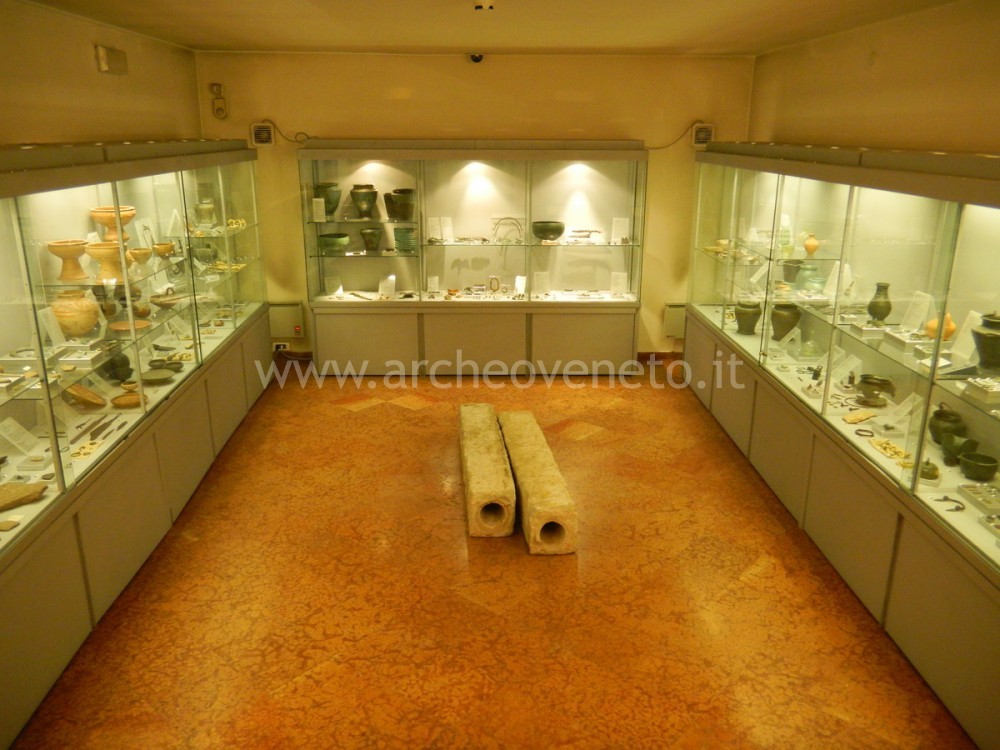 Getting down the steps, you reach the second room, in the centre of which two big pipes made of stone are located. Only eight out of fifteen showcases at present are definitively set (the first, beginning from the left). Two fragments of polychrome mosaics are hanging on the two sides of the doorway; the left one, from via Piave, portrays Leda and the Swan (2nd-3rd cent. A.D.); the right one, from via S. Lucano, shows a geometric motif (3rd-4th cent. A.D.). Under the first one there are some amphorae from Polpet, cut in order to be re-used as graves (first half of the 1st cent. A.D.); under the second one there are a millstone and some fistulae (pipes) in lead of municipal property (1st cent. A.D.). The first three cases collect items of different origins. In particular there are four hoards of bronze objects discovered in Cornadon di Monte Talvena (9th-early 8th cent. B.C.), Noal di Trichiana and Monte Dolada (14th-12th century B.C.) and S. Pietro in Tuba (12th-9th century B.C.). Besides weapons made of copper and bronze exceptionally well made are to be stressed; they date back to the half of the 4th millennium B.C. and to the second half of the 2nd millennium B.C. and are exposed on the top shelf of the first case (still being set). The fourth case, very singular if compared to the rest of the collection, includes a collection of vases produced in Vulci (8th cent. B.C.-first half of the 6th cent. B.C.) belonging to the Orsini-Margola’s donation. On the top shelf there are some etrusco-geometric painted vases, on the mid one there are etrusco-geometric ceramics of different shapes, most of which are painted, and on the lower one etrusco-corinthian ceramic and bucchero. It is noteworthy a big bronze halstattian type key from Trichiana (second half of the 7th cent. B.C.), discovered in a small ritual grave; it is exposed on the top shelf of the fifth case together with iron keys (2nd-1st cent. B.C.) and a bronze "Certosa type" fibula (5th-4th cent. B.C.). The lower shelf and the whole next case enlighten some rich Prehistoric funeral outfits discovered in different places in the province of Belluno (Ponte nelle Alpi, Alpago, Longarone). Other funeral outfits are located in the seventh and eighth cases. The outfit belonging to the tomb 1865/3 from Caverzano, loc. Masiera, is particularly striking; it is composed of bronze vases (lebes, situla, ribbed cist) and objects (armilla, fragmentary sceptre) dating back to the second half of the 6th cent. B.C. Other rich outfits come still from Caverzano; in one of these, discovered in loc. Limade, a beautiful bronze lebes/ossuary and a knife with iron sheath. Getting down the steps, you reach the second room, in the centre of which two big pipes made of stone are located. Only eight out of fifteen showcases at present are definitively set (the first, beginning from the left). Two fragments of polychrome mosaics are hanging on the two sides of the doorway; the left one, from via Piave, portrays Leda and the Swan (2nd-3rd cent. A.D.); the right one, from via S. Lucano, shows a geometric motif (3rd-4th cent. A.D.). Under the first one there are some amphorae from Polpet, cut in order to be re-used as graves (first half of the 1st cent. A.D.); under the second one there are a millstone and some fistulae (pipes) in lead of municipal property (1st cent. A.D.). The first three cases collect items of different origins. In particular there are four hoards of bronze objects discovered in Cornadon di Monte Talvena (9th-early 8th cent. B.C.), Noal di Trichiana and Monte Dolada (14th-12th century B.C.) and S. Pietro in Tuba (12th-9th century B.C.). Besides weapons made of copper and bronze exceptionally well made are to be stressed; they date back to the half of the 4th millennium B.C. and to the second half of the 2nd millennium B.C. and are exposed on the top shelf of the first case (still being set). The fourth case, very singular if compared to the rest of the collection, includes a collection of vases produced in Vulci (8th cent. B.C.-first half of the 6th cent. B.C.) belonging to the Orsini-Margola’s donation. On the top shelf there are some etrusco-geometric painted vases, on the mid one there are etrusco-geometric ceramics of different shapes, most of which are painted, and on the lower one etrusco-corinthian ceramic and bucchero. It is noteworthy a big bronze halstattian type key from Trichiana (second half of the 7th cent. B.C.), discovered in a small ritual grave; it is exposed on the top shelf of the fifth case together with iron keys (2nd-1st cent. B.C.) and a bronze "Certosa type" fibula (5th-4th cent. B.C.). The lower shelf and the whole next case enlighten some rich Prehistoric funeral outfits discovered in different places in the province of Belluno (Ponte nelle Alpi, Alpago, Longarone). Other funeral outfits are located in the seventh and eighth cases. The outfit belonging to the tomb 1865/3 from Caverzano, loc. Masiera, is particularly striking; it is composed of bronze vases (lebes, situla, ribbed cist) and objects (armilla, fragmentary sceptre) dating back to the second half of the 6th cent. B.C. Other rich outfits come still from Caverzano; in one of these, discovered in loc. Limade, a beautiful bronze lebes/ossuary and a knife with iron sheath.
The next cases at present are being set. Inside there are different Roman and Early Middle Ages items discovered in the city and in different sites of the countryside of Belluno, many of which are conspicuous for their valuable manufacturing or preservation.
|

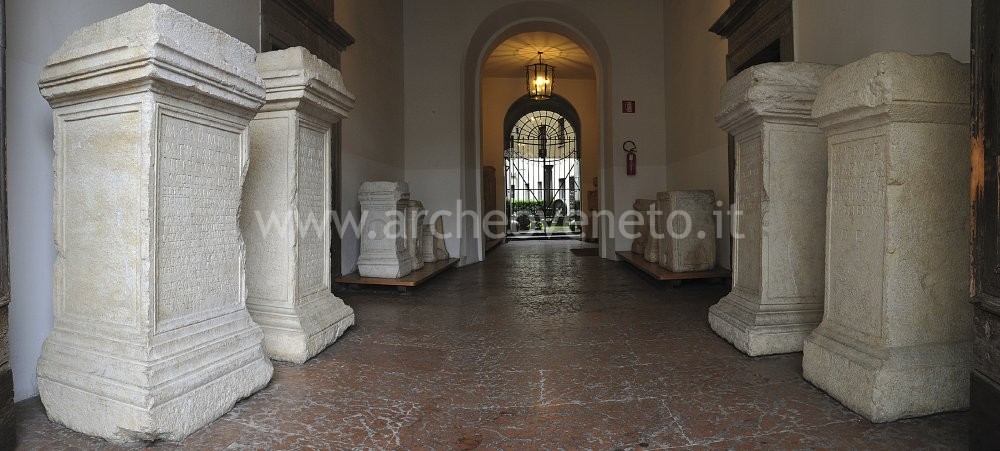 The lapidary displays honorary, votive and funerary inscriptions from the mid and late imperial age, coming from Belluno and from Pagani’s collection. Bases for statues dedicated to the patron Capertia Valeriana, to the eques Marcus Carminius Pudens and to the emperor Valerius Constantius are particularly noteworthy, but even the funerary inscription of the duovir Titus Sertorius Proculus and some fragments of sarcophagi are to be stressed. The lapidary displays honorary, votive and funerary inscriptions from the mid and late imperial age, coming from Belluno and from Pagani’s collection. Bases for statues dedicated to the patron Capertia Valeriana, to the eques Marcus Carminius Pudens and to the emperor Valerius Constantius are particularly noteworthy, but even the funerary inscription of the duovir Titus Sertorius Proculus and some fragments of sarcophagi are to be stressed.
It is noteworthy the integral sarcophagus with scenes of hunt, dedicated to the patron Gaius Flavius Ostilius Sertorianus and his wife; at present it is located in the Civic Library (Palazzo Crepadona).
|
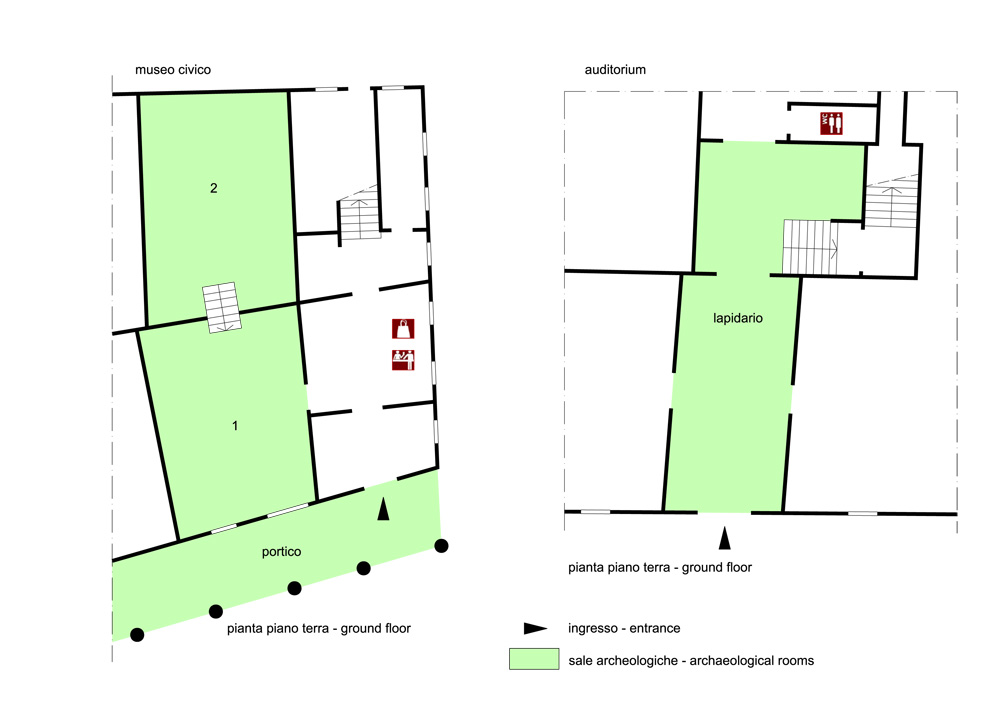
Admission: Negli orari di apertura
Ticket: Si
Price: Full fare: 3 €; reduced fare: 1,50 € (adults over 60 years old, soldiers, students of every level, groups made of more than 10 people); free admission (children under 6 years of age, students belonging to schools of the province of Belluno with a guide, journalists, museum directors and keepers, people with handicaps with an escort)
 School access School access
Opening Days
| Tipology |
When |
Specs |
| Summer |
Tuesday |
10.00-13.00, 15.00-18.00 |
| Summer |
Wednesday |
10.00-13.00, 15.00-18.00 |
| Summer |
Thursday |
10.00-13.00, 15.00-18.00 |
| Summer |
Friday |
10.00-13.00, 15.00-18.00 |
| Summer |
Saturday |
10.00-13.00, 15.00-18.00 |
| Summer |
Sunday |
10.00-13.00, 15.00-18.00 |
| Winter |
Monday |
9.00-13.00 |
| Winter |
Tuesday |
9.00-13.00, 14.30-18.00 |
| Winter |
Wednesday |
9.00-13.00 |
| Winter |
Thursday |
9.00-13.00, 15.00-18.00 |
| Winter |
Friday |
9.00-13.00, 15.00-18.00 |
| Winter |
Saturday |
15.00-18.00 |
| Winter |
Sunday |
15.00-18.00 |
Closed on 11 November, 25 December, 1 January, 1 May and 15 August.
Recommended tour time (minutes): 50
 Toilet Toilet
 Bookshop Bookshop
Among the revised catalogues of the Civic Museum, the one of the archaeological section at present is not available.
 Information boards Information boards
Italian
 Captions under exhibits Captions under exhibits
Italian
 Educational activities Educational activities
Workshops and didactic visits.
 Educational workshops Educational workshops
The workshop is located in the lapidary in the passage-way of the Auditorium.
 Library and documentation centre Library and documentation centre
The Civic Library is located in the nearby Palazzo Crepadona.
| Bonomi S. 1992, Nuovi dati archeologici su Belluno, in Immagini dal tempo. 40.000 anni di storia nella provincia di Belluno, Cornuda, pp. 137-163. |
| Breve guida del Museo Civico di Belluno 1992, Belluno. |
| Musei e raccolte archeologiche del Veneto 2004, a cura di Di Mauro A., Dosson di Casier, pp. 29-32. |
| Gangemi G. 2005, Dall’età del Ferro alla romanizzazione, in Belluno. Nel regno delle Dolomiti, Cittadella, pp. 44-48. |
| Bonetto J. 2009, Veneto (Archeologia delle Regioni d’Italia), Roma, pp. 422-424. |
|

